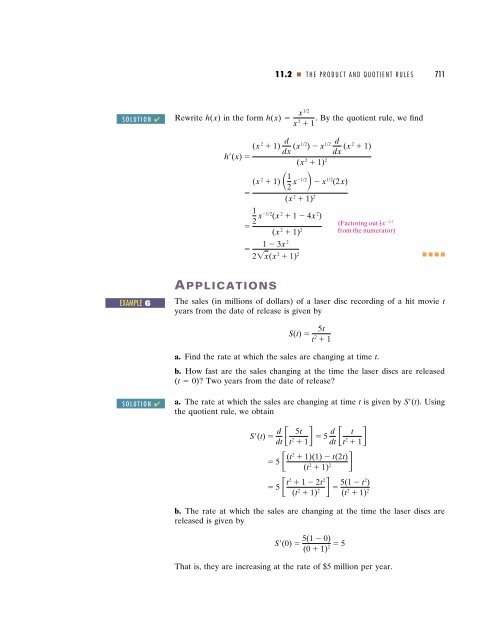11DIFFERENTIATION - Department of Mathematics
11DIFFERENTIATION - Department of Mathematics
11DIFFERENTIATION - Department of Mathematics
Create successful ePaper yourself
Turn your PDF publications into a flip-book with our unique Google optimized e-Paper software.
11.2 THE PRODUCT AND QUOTIENT RULES 711<br />
SOLUTION ✔ Rewrite h(x) in the form h(x) x1/2<br />
x 2 . By the quotient rule, we find<br />
1<br />
EXAMPLE 6<br />
SOLUTION ✔<br />
(x<br />
h(x) <br />
2 1) d<br />
dx (x1/2 ) x<br />
(x 2 1) 2<br />
1/2 d<br />
(x<br />
<br />
2 1)1 2 x1/2 x1/2 (2x)<br />
(x 2 1) 2<br />
1<br />
2<br />
<br />
x1/2 (x 2 1 4x 2 )<br />
(x 2 1) 2<br />
<br />
2 1 3x<br />
APPLICATIONS<br />
dx (x 2 1)<br />
(Factoring out x 1/2<br />
from the numerator)<br />
2x(x 2 1) 2 <br />
The sales (in millions <strong>of</strong> dollars) <strong>of</strong> a laser disc recording <strong>of</strong> a hit movie t<br />
years from the date <strong>of</strong> release is given by<br />
S(t) 5t<br />
t 2 1<br />
a. Find the rate at which the sales are changing at time t.<br />
b. How fast are the sales changing at the time the laser discs are released<br />
(t 0)? Two years from the date <strong>of</strong> release?<br />
a. The rate at which the sales are changing at time t is given by S(t). Using<br />
the quotient rule, we obtain<br />
S(t) d<br />
dt 5t<br />
t2 5<br />
1 d<br />
dt t<br />
t2 1<br />
5 (t2 1)(1) t(2t)<br />
(t 2 1) 2<br />
5t2 1 2t 2<br />
(t2 1) 2 <br />
<br />
5(1 t2 )<br />
(t2 1) 2<br />
b. The rate at which the sales are changing at the time the laser discs are<br />
released is given by<br />
S(0) <br />
5(1 0)<br />
5 2 (0 1)<br />
That is, they are increasing at the rate <strong>of</strong> $5 million per year.

















